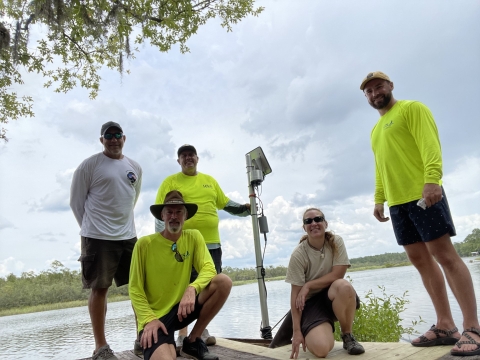The mission, if you choose to accept it, will examine temperature gradient stratification in Cooper's Basin that will lead to the validation of Gulf sturgeon (Acipenser oxyrhynchus desotoi) use as a summer refugia holding area. The team will need to design and deploy a temperature array that may not violate these parameters: 1) The temperature array may not have any floating lines or buoys attached that can cause entanglement to sturgeon, 2) The temperature array must be deployed sub-surface without any designated markers and may not impede boat traffic, and 3) The temperature array must be retrievable.
In addition, the City of Milton has proposed a new wastewater treatment plant upstream of Cooper's Basin. The team will also need to install a solar powered multi-parameter water quality station in Cooper's Basin. The water in Cooper's Basin comes from the Blackwater River and is stained by tannins, has very low visibility, and average depths of 20 - 25 feet. Good luck, the sturgeon in Cooper's Basin are waiting...
This looks like a job for the Dive Team!
Project Background
Cooper's Basin is in Milton, FL (30.652492, -86.992029) off the Blackwater River and encompasses an area of approximately three acres; it is used in the summer by hundreds and hundreds of adult Gulf sturgeon. Why do sturgeon continue to congregate in Cooper's Basin year after year? The general theory is Cooper's Basin must have groundwater seeps that are providing cooler water temperatures, which allow sturgeon to reduce metabolic energy use before Fall migration. A temperature gradient has been detected, with a measured difference of about 3-4°C between the bottom and the surface temperatures. However, a long-term study has not been conducted that could examine diurnal temperature differences at multiple locations or river temperatures in the vicinity.
Project Design
To eliminate entanglement, the team built nine bases to serve as the temperature array in Cooper's Basin. The bases were made with poured concrete (40 lbs.), PVC housings, and u-bolts. The housings accepted 1.5-inch PVC pipes (10 ft.), and the u-bolts were used to attach lines to lower the structure structure
Something temporarily or permanently constructed, built, or placed; and constructed of natural or manufactured parts including, but not limited to, a building, shed, cabin, porch, bridge, walkway, stair steps, sign, landing, platform, dock, rack, fence, telecommunication device, antennae, fish cleaning table, satellite dish/mount, or well head.
Learn more about structure to the bottom. Hobo temperature loggers were attached to the PVC pipes at 1 foot and 10 foot intervals. The array locations were created in ArcGIS software, and points were transferred to boat mounted GPS units. In addition, surface temperature loggers were placed inconspicuously around Cooper's Basin and the Blackwater River.
Methods
Due to the abundance of large adult sturgeon and the absence of light and visibility in Cooper's Basin, the dive team spent a day practicing the methods that would be used in deploying the temperature array at Morrison Springs, FL. The spring run had depths of 17 feet and crystal clear water that allowed the dive team and dive safety officer to determine the effectiveness and appropriate safety protocols for the divers as they descended to the temperature array bases and detached the lowering lines. The dive team practiced with limited visibility masks to replicate low visibility conditions that were anticipated at Cooper's Basin.
Device Deployment
The team consisted of two divers, two boat operators, and an assistant. On the deployment day, the team assembled at Cooper's Basin with two vessels, equipment, tools, temperature array, and water quality station. The first order of business was to complete the underwater work deploying the temperature array and securing the underwater housing for the water quality station. The team used one vessel to carry the divers and temperature array bases to each predetermined site. The second vessel moved into position to the next predetermined site as a safety vessel.
The divers entered the water and the assistant lowered the array base into the water using guidelines. As the base touched the bottom, the divers followed the guideline to the base, settled the base into the substrate, ensured the position of the pipes were vertical, and detached the guideline swivel snaps. As the divers were confident that the base was in position and upright, the divers signaled to the assistant with three tugs of the guidelines, and the assistant pulled the divers back to the vessel at a slow rate. The divers swam from the main vessel to the second anchored vessel, while the main vessel repositioned to the next site to repeat the process. This process was repeated nine times and it was flawless!
Next, the team moved to a private residence with permission to assemble the water quality station on their private dock. The divers were able to secure a 4-inch PVC pipe (20 ft.) to a submerged tree at the end of the dock to a depth of 15 feet. Once the pipe was anchored to the bottom, the non-divers were able to secure the pipe to the dock and begin assembling the solar powered station that transmits water quality data in real time. Again, this process was flawless.
The final procedure involved deploying ten additional temperature loggers to monitor air temperature, surface temperatures, and river temperature in and around Cooper's Basin and the Blackwater River.
MISSION POSSIBLE: Results
The water quality station started sending data immediately upon deployment. At the time of this writing, the team has not had a chance to download temperature data. A huge acknowledgement to the team effort in the collaboration, design, and deployment of this project. There were a lot of moving parts to this process, and the team really worked together to accomplish the objectives!






